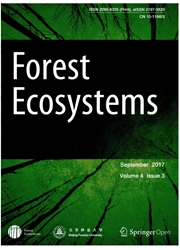

 中文摘要:
中文摘要:
垂直坡度合并连续地变化的多重资源坡度。因此,沿着垂直坡度在山上研究花的模式是重要的沿着环境坡度揭示植物群的常规模式并且沿着这些坡度和他们的生物健康在生物多样性理解变化。这研究被设计沿着 Dawei 山的国家自然保护区的垂直坡度探索花的作文的特征和花的模式的生态的意义,在云南省的东南定位了。我们沿着垂直植被横断根据我们的领域调查作为举起的功能分析了植物群的结构的特征和它的花的部件的分发模式。我们执行了系统的簇分析以便沿着坡度由举起决定花的变化的划分的线并且在花的作文的垂直变化上学习了山地气候的效果。学习出现:1 ) 明显的边界,区分热带分发,在约 1,500 的举起被定位 m,它把热带雨林与分开常绿树阔叶的森林;2 ) 潮湿的雨林在 700 m 举起下面被发现,在 700 和 1,500 m 之间的山雨林,季风常绿树在 1,300 和 1,800 m 和山之间的阔叶的森林苔状常绿树在 1,800 m 上面的阔叶的森林。非代表性的山苔状的矮子森林(在 2,100 m 上面) 在区域被发现在上上风山坡上的方面和贫瘠陆地;3 ) Hopea mollissima 是山雨林的主要部件种类之一,但是它不应该在是的潮湿的雨林被看作主要指示物种类,这通常被接受。
 英文摘要:
英文摘要:
Abstract Vertical gradients incorporate multiple resources gradients which vary continuously. Therefore, research on mountain floristic patterns along vertical gradients is important to reveal regular patterns of the flora along environmental gradients and to under- stand the changes in biodiversity along these gradients and their biological fitness. This study was designed to explore the character- istics of the floral compositions and ecological significance of floristic patterns along the vertical gradients of the National Nature Reserve of Dawei Mountain, located in the southeast of Yunnan Province. We analyzed the structural characteristics of the flora and the distribution patterns of its floristic components as a function of elevation on the basis of our field investigations along vertical vegetation transects. We carried out a systematic cluster analysis in order to determine the dividing line of floristic changes by eleva- tion along gradients and studied the effects of mountain climate on the vertical variation of floristic composition. The study shows: 1) that the obvious boundary, which differentiates tropical distribution, is located at an elevation of approximately 1,500 m, which separates the tropical rain forests from the evergreen broad-leaved forests; 2) that humid rain forests are found below 700 m elevation, mountain rain forests between 700 and 1,500 m, monsoon evergreen broad-leaved forests between 1,300 and 1,800 m and mountain mossy evergreen broad-leaved forests above 1,800 m. Non-representative mountain mossy dwarf forests (above 2,100 m) in the area are found on the windward sides and barren lands on mountain slopes; 3) that Hopea mollissima is one of the major component species of mountain rain forests, but it should not be considered as the major indicator species in humid rain forests as is generally accepted.
 同期刊论文项目
同期刊论文项目
 同项目期刊论文
同项目期刊论文
 期刊信息
期刊信息
